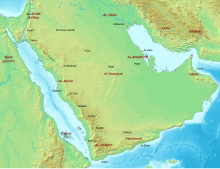al-Faddayni

Sa'id ibn Khalid ibn Muhammad ibn Abd Allah ibn Amr ibn Uthman ibn Affan al-Uthmani (
Background
Sa'id ibn Khalid ibn Muhammad ibn Abd Allah ibn Amr ibn Uthman was a descendant of Caliph
Revolt

During the
Abu al-Umaytir was deposed in 813 by the
Around the same time the Umayyad revolt in Damascus dissipated, probably still in 813, al-Faddayni proclaimed himself caliph. He allied with the Yaman and first moved against the Qays in his general vicinity, pursuing and killing members of the faction from the Banu Sa'd tribe. Ibn Bayhas dispatched his brother Yahya ibn Salih against al-Faddayni. Yahya besieged and chased him out of al-Faddayn, which was subsequently destroyed. Yahya next destroyed the fortress of Ziza in the Balqa near Amman.[3]
Al-Faddayni then set up headquarters at Masuh, also near Amman, while a fellow Umayyad, Yahya ibn al-Hakam, controlled Amman proper. They were reinforced by Yamani tribesmen, including the Bali, as well as parts of the Qaysi Banu Fazara and groups from the Jordan Valley. Umayyad relatives and remnants of Abu al-Umaytir's supporters from Damascus also joined.[3][1] In all, his forces swelled to some 20,000 men.[8] Yahya ibn Salih moved against the Umayyads, defeated them, and put al-Faddayni to flight once more. He barricaded himself at Hisban, whereafter his tribal support disbanded and nothing more is heard of him.[3][8]
According to the historian Wilferd Madelung, the abortive revolt of al-Faddayni was the last major attempt to reestablish the Umayyad Caliphate in Syria.[8] The historian Paul M. Cobb notes that one more rebellion occurred in 906 by a notable claiming Sufyanid descent, but it was suppressed soon after.[9]
| Family tree of Umayyad claimants to the caliphate during the Fourth Muslim Civil War
| |||||||||||||||||||||||||||||||||||||||||||||||||||||||||||||||||||||||||||||||||||||||||||||||||||||||||||||||||||||||||||||||||||||||||||||||||||||||||||||||||||||||||||||||||||||||||||||||||||||||||||||||||||||||||||||||||||||||||||||||||||||||||||||||||||||||||||||||||||||||||||||||||||||||||||||||||||||||||||||||||||||||||||||||||||||||||||||||||||||||||||||||||||||||||||||||||||||||||||||||||||||||||||||||||||||||||||||||||||||||||||||||||||||||||||||||||||||||||||||
|---|---|---|---|---|---|---|---|---|---|---|---|---|---|---|---|---|---|---|---|---|---|---|---|---|---|---|---|---|---|---|---|---|---|---|---|---|---|---|---|---|---|---|---|---|---|---|---|---|---|---|---|---|---|---|---|---|---|---|---|---|---|---|---|---|---|---|---|---|---|---|---|---|---|---|---|---|---|---|---|---|---|---|---|---|---|---|---|---|---|---|---|---|---|---|---|---|---|---|---|---|---|---|---|---|---|---|---|---|---|---|---|---|---|---|---|---|---|---|---|---|---|---|---|---|---|---|---|---|---|---|---|---|---|---|---|---|---|---|---|---|---|---|---|---|---|---|---|---|---|---|---|---|---|---|---|---|---|---|---|---|---|---|---|---|---|---|---|---|---|---|---|---|---|---|---|---|---|---|---|---|---|---|---|---|---|---|---|---|---|---|---|---|---|---|---|---|---|---|---|---|---|---|---|---|---|---|---|---|---|---|---|---|---|---|---|---|---|---|---|---|---|---|---|---|---|---|---|---|---|---|---|---|---|---|---|---|---|---|---|---|---|---|---|---|---|---|---|---|---|---|---|---|---|---|---|---|---|---|---|---|---|---|---|---|---|---|---|---|---|---|---|---|---|---|---|---|---|---|---|---|---|---|---|---|---|---|---|---|---|---|---|---|---|---|---|---|---|---|---|---|---|---|---|---|---|---|---|---|---|---|---|---|---|---|---|---|---|---|---|---|---|---|---|---|---|---|---|---|---|---|---|---|---|---|---|---|---|---|---|---|---|---|---|---|---|---|---|---|---|---|---|---|---|---|---|---|---|---|---|---|---|---|---|---|---|---|---|---|---|---|---|---|---|---|---|---|---|---|---|---|---|---|---|---|---|---|---|---|---|---|---|---|---|---|---|---|---|---|---|---|---|---|---|---|---|---|---|---|---|---|---|---|---|---|---|---|---|---|---|---|---|---|---|---|---|---|---|---|---|---|---|---|---|---|---|---|---|---|---|---|---|---|---|---|---|---|---|---|---|---|---|---|---|---|---|---|---|---|---|---|---|---|---|---|---|---|---|---|---|---|---|---|---|---|---|---|---|
Umayyad rebel claimants to the caliphate during the Fourth Fitna
Sufyanid caliphs
Marwanid caliphs
Caliph Uthman
| |||||||||||||||||||||||||||||||||||||||||||||||||||||||||||||||||||||||||||||||||||||||||||||||||||||||||||||||||||||||||||||||||||||||||||||||||||||||||||||||||||||||||||||||||||||||||||||||||||||||||||||||||||||||||||||||||||||||||||||||||||||||||||||||||||||||||||||||||||||||||||||||||||||||||||||||||||||||||||||||||||||||||||||||||||||||||||||||||||||||||||||||||||||||||||||||||||||||||||||||||||||||||||||||||||||||||||||||||||||||||||||||||||||||||||||||||||||||||||||
References
- ^ a b Madelung 2000, p. 340.
- ^ Ballian 2012, p. 212.
- ^ a b c d e Cobb 2001, p. 63.
- ^ Genequand 2020, p. 257.
- ^ Cobb 2001, pp. 57–58.
- ^ Cobb 2001, p. 62.
- ^ Madelung 2000, pp. 339–340.
- ^ a b c Madelung 2000, p. 341.
- ^ Cobb 2001, pp. 172–173.
Bibliography
- Ahmed, Asad Q. (2011). The Religious Elite of the Early Islamic Ḥijāz: Five Prosopographical Case Studies. Oxford: Unit for Prosopographical Research, Linacre College, University of Oxford. ISBN 978-1-900934-13-8.
- Ballian, Anna (2012). Byzantium and Islam: Age of Transition, 7th-9th Century. New York: Metropolitan Museum of Art. ISBN 978-1-58839-457-6.
- Cobb, Paul M. (2001). White Banners: Contention in 'Abbasid Syria, 750–880. SUNY Press. ISBN 978-0791448809.
- Madelung, Wilferd (2000). "Abūʾl-Amayṭar al-Sufyānī". Jerusalem Studies in Arabic and Islam. 24: 327–341.
- Genequand, Denis (2020). "Elites in the Countryside: The Economic and Political Factors Behind the Umayyad Desert Castles". In Marsham, Andrew (ed.). The Umayyad World. London and New York: Routledge. pp. 240–266. ISBN 978-1-3174-3005-6.
